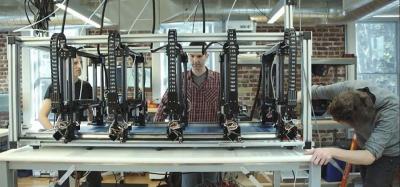Back in March 2016 Slash gear ran this item about Autodesk's Project Escher printer. This new 3D printer from Autodesk wants to revolutionize 3D printing technology by allowing users to print larger items. Project Escher is an assembly line of 3D printers with a smart setup controller that is able to control an endless number of print heads to create larger items. Rather than having a single printer working on one large project, Project Escher has multiple print heads each working on one section of an object.
By having multiple heads working on a large project, the item can be completed more quickly. “By intelligently distributing toolpaths between multiple collaborating machines, systems enabled by Project Escher can manufacture parts faster than traditional 3D printers,” say the developers. “Project Escher is a parallel processing system where numerous independent tools collaborate to fabricate a design. It’s faster because whatever the job is, there are more workers on that job. And there is no compromise to detail because we’re using proven existing technology.”
Each of the independent printers has interchangeable tool heads. The company hopes to make the tool head changing automatic, along the lines of how a CNC machine works. The team of designers also hopes to create Pick-and-Place tools that would put pre-made components into an object during the printing.
Autodesk also expects to integrate other technologies into the printer including laser cutting. One key bit of information that is outstanding right now is when Project Escher will hit the market. Developers of Project Escher are looking at a 2017 or 2018 launch. The faster multi-head printer would be able to complete a larger piece for inspection the same day.
As exciting as the technology is, the industry has been waiting for signs that Project Escher would actually be available to the public. At CES this year, the wait was put to an end as Colorado-based start-up Titan Robotics showed off Cronus, the first commercially available 3D printer relying on Project Escher technology.
> > > Continue to read full article





